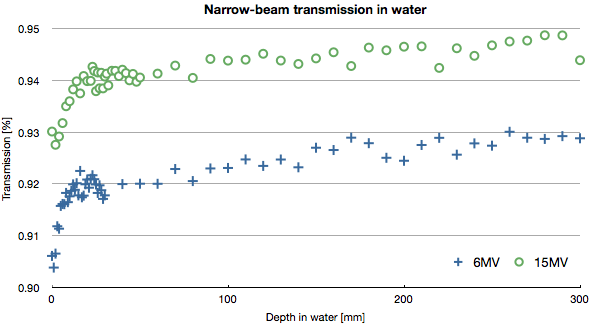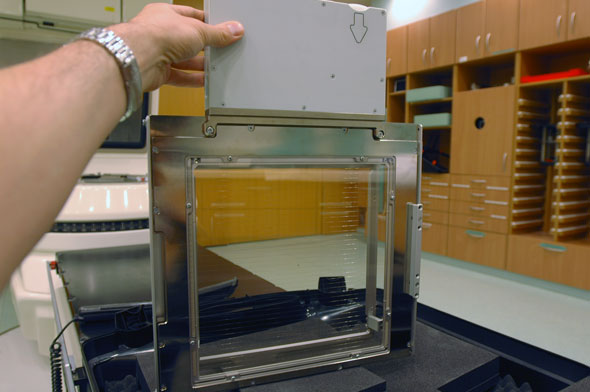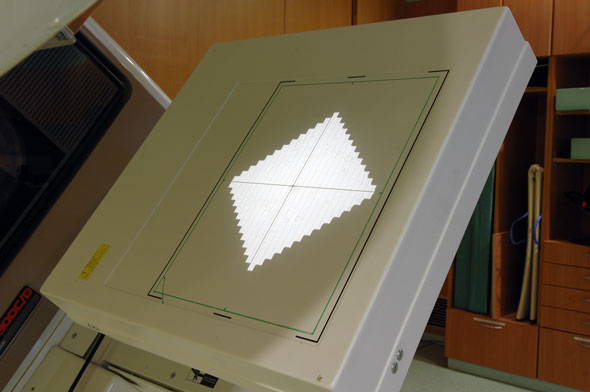Radiation
The radiation transmission factor (=tray factor) of DAVID is the ratio of the doses measured with and without DAVID in the beam, for the same number of monitor units:
![]()
This equation uses the ESTRO symbols for collimator opening (c), depth (z) and distance from the source (f). According to ESTRO Booklet 3, the transmission factor "is assumed to be independent of the distance to the source provided that the two doses are measured at the same distance", and "depends slightly on the collimator opening because of additional photons scattered by the shadow tray". It "is defined at the reference depth". "It is dependent on the depth of measurement. It will be closer to unity at shallower depths due to the contributions of electrons and photons scattered from the tray".
We determined the transmission factor in two ways: in (near) narrow beam geometry for different depths and by using a more realistic 10x10 cm field size and the usual reference depth of 10 cm.
(Near) Narrow Beam Transmission
Transmission was measured in water at SSD100, field size 1x1 cm, using a 60008 photon diode. Two depth dose curves, with and without DAVID, were measured absolutely (i.e., with fixed time per point, not against a reference detector).
Each point in the following plot is the reading with DAVID divided by the reading without DAVID at the same depth, in other words: the transmission factor at this depth. Measuring time per point was one second. Linac dose rate was stable at 300 MU/min (important!).

Interestingly, the factor does not get closer to unity at shallower depths. It looks like due to the small field size, photons and electrons are scattered out of the field when they pass DAVID, reducing the DAVID reading and the transmission factor. Beyond dmax, the factor nearly remains constant.
Since no one will use this field size clinically, let's move on to a more typical 10x10 cm field.
Transmission for a 10x10 cm Field
Transmission was measured isocentrically in a solid phantom consisting of 30x30 cm slabs of RW3. SSD was 90 cm. A 30001 Farmer chamber was placed in the reference depth of 10 cm. Ten readings were taken with and without DAVID in the beam, and averaged. The measured transmission factors are:
- 6 MV: 0.9273 ± 0.0005
- 15 MV: 0.9507 ± 0.0002
which means that DAVID absorbs about 7% for 6 MV and 5% for 15 MV.
This setup has a higher accuracy than the previous one due to longer acquisition times, but is limited to a single depth. The results for 10x10 cm agree well with the 1x1 cm values, especially for 6 MV.
If one plans to configure his/her TPS with a transmission factor for DAVID, the measurement setup actually chosen should also take into account the TPS vendor's recommendations. And, of course, you should measure your own factors, not take ours!
Light

(The light absorptance of the Makrolon windows is very small.)

(MLC test shape projected on the PortalVision detector. The crosshairs and the dirt spots are on the linac's Mylar foil. The measuring wires of DAVID are clearly visible.)